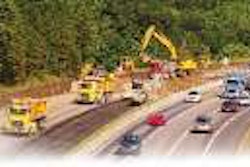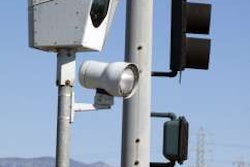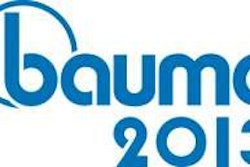
By John Latta, [email protected]
You jack it up, you slide it. Simple.
But the Sellwood Bridge is not small. It is 1,100 feet long (a continuous structure) and 3,400 tons.

The move saves Multnomah County millions of dollars by shaving up to a year of construction time and saving drivers a long detour. The proposal was to save the original span by moving it to the side, reopening it to traffic and leaving room at the original site for construction of a new $307.5 million bridge that will be completed in 2016.
The moving work was done by Portland-based Omega Morgan, which says its plan was the only one that did not require destruction of the old (1924) bridge that would have required 30,500 vehicles a day to re-route miles away to other bridges. And, says the company, there were other benefits to the plan including reducing environmental impact and improving safety for bridge users and workers.
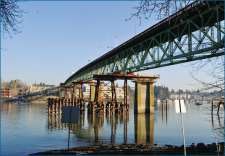 The continuous Sellwood Bridge span bridge rests on its new steel piers after the move.
The continuous Sellwood Bridge span bridge rests on its new steel piers after the move.Multnomah County encompasses the most populous area in Oregon, including the city of Portland and the heavily travelled Sellwood Bridge. The project was one of the largest the county has undertaken in decades, according to officials managing the project. The county say that “considering the rarity of four-span bridges, the Sellwood move could be the first time such an operation has been performed for a structure of this type. This is,” says the county, “one of the longest, oldest structures to be moved in this way.”
Omega Morgan assigned a team led by Vice President of Engineering Ralph Di Caprio, whose experience in executing complicated moves includes the removal of Portland’s Sauvie Island Bridge and installation of the new bridge, managing the Third Avenue Bridge project in New York City, moving two 900-ton spans on the Hood Canal Bridge and the transport and launch of the Kalama River Bridge.
The move took 12 hours
The crew raised the truss span vertically by several inches and then pushed it north by hydraulic jack-and-slide beams. It was then slowly moved twice as far on the west end (66 feet) than at the east end (33 feet) to accommodate for the new, permanent bridge being wider at the west end, flaring from two to four lanes to add traffic capacity. The truss span was then moved on a radius, along a curving path, adding to the complexity of the execution.
Multnomah County’s fact sheet for the ‘Sellwood Bridge detour structure and truss translation’ reveals the complexity of the job.
The heavy work had its lighter side. A common dishwashing soap was used to lubricate pads on the slides.
Multnomah County’s fact sheet for the ‘Sellwood Bridge detour structure and truss translation’ reveals the complexity of the job.
• The actual length on the continuous steel truss between end bearing points is 1,091 feet and 2-1/4 inches; adding the overhang past the bearings makes it about 1100 feet long overall.
• The steel structure consists of four spans between support piers but is continuous over the entire 1,100-foot length with no hinges or expansion joints. Four-span continuous trusses are exceedingly rare. We’re aware of only a couple of others in the United States.
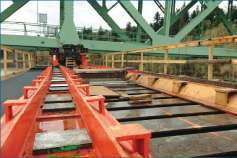 Special jacking and sliding equipment was needed to “skid” this long, heavy and old bridge sideways to temporary new piers.
Special jacking and sliding equipment was needed to “skid” this long, heavy and old bridge sideways to temporary new piers.• The truss is [before the move] supported on five concrete piers, three in the river and two at the east and west shorelines. Lengths of the four spans from west to east are about 245 feet, 300 feet, 300 feet and 246 feet (give or take a few inches).
• At each of the five piers, the truss is supported on two large steel bearings, with one bearing under the north side of the truss and one under the south side.
• The individual parts of the steel truss were fabricated in 1924.
Objective
• The Sellwood truss will be moved (“translated”) sideways to a new location north of the existing bridge in order to serve as a temporary detour structure while the new Sellwood Bridge is built at the present bridge location.
• At the new location, the truss will be supported on five temporary steel “bents” or piers. The contractor has installed the new bents at the same spacings as the existing concrete piers. Thus the new bents will support the truss at the same 10 bearing points (two per bent) where the concrete piers support it now.
• The entire 1,100-foot long, four-span truss will be moved sideways to its new location as a single unit. The bridge is moved in a horizontal slide, rather than a vertical pick and move.
• Due to the necessary locations of the temporary east and west approaches to the detour bridge, the final location of the truss after translation will be at a “skew” to its present alignment. The east end of the truss will be moved north about 33 feet and the west end will be moved north about 66 feet. This means that the truss will travel along a curved path as it is translated.
Translation Contractors
• The translation operation will be carried out by two contractors working together: the Slayden/Sundt Joint Venture and Omega Morgan. Omega Morgan is a subcontractor to Slayden/Sundt.
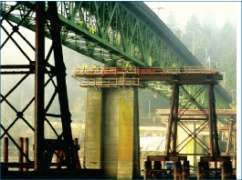 Omega Morgan crews in final preparation to slide the Sellwood span from its old concrete piers to new, temporary, steel piers.
Omega Morgan crews in final preparation to slide the Sellwood span from its old concrete piers to new, temporary, steel piers.• The Slayden/Sundt Joint Venture is Construction Manager/General Contractor (CMGC) for the entire Sellwood Bridge replacement project. The joint venture consists of Slayden, an Oregon-based heavy construction contractor, and Sundt, an Arizona-based general contractor.
Translation Methods and Equipment
• Since the truss is continuous over its full 1,100-foot length, it will be important to support the truss at the 10 main bearing points (two per pier) throughout the translation operation. Otherwise the load-carrying capacity of truss members could be exceeded.
• To support the truss at all 10 bearing points during translation, the SSJV has installed steel “translation beams” from the five old concrete piers to the five new temporary steel bents. Two translation beams will be used at each pier to accommodate Omega Morgan’s skidding (or sliding) equipment. One translation beam will be positioned on either side (east and west) of the bearings that support the truss on the piers.
• Omega Morgan’s equipment will lift the truss off the concrete piers, then slide the truss along the translation beams to the steel temporary bents. Hydraulic jacks will push the truss on its journey.
• Omega Morgan will first install U-shaped “track beams” on top of the translation beams from the concrete piers to the steel bents. Teflon pads are glued to the track beams to provide slick sliding surfaces.
• To actually lift and slide the bridge truss, Omega Morgan will use their standard “skid beams.” The skid beams are 14-foot long ski-shaped steel units that slide on the Teflon pads in the track beams. Four skid beams will be used at each of the concrete piers, with two of the skid beams located at the north side bridge bearing and two at the south side bearing. At each bridge bearing, the two skid beams will sit on the track beams on the east and west sides of the bearing.
• Each skid beam will have two vertically oriented 150-ton capacity hydraulic jacks for lifting the truss off the concrete piers and lowering it onto the temporary steel bents. With two skid beams at each bearing, this means that four jacks will lift the truss at each bearing. Since there are 10 bearings in total (two per pier), OM will be using 40 jacks to lift the truss. At each of the three river piers, the weight of the truss (including concrete roadway deck) is about 900 tons. At each of the end piers, the bridge weight is about 340 tons. The total weight of the truss span is estimated to be about 3,400 tons.
• In preparation … the SSJV will install custom-designed steel “cradles” at each truss bearing (10 cradles total) … to carry the weight of the truss from the bearing to the four lifting jacks.
• To move the skid beams and truss along the track beams, OM will use 10 horizontally oriented 75-ton capacity hydraulic jacks to push on the south side skid beams. The north skid beams and south skid beams will be tied together to assure that they move together. In OM’s system, the pushing jacks are pinned to the rear ends of the skid beams and push against clips on the sides on the track beams.
Due to the slick surface provided by the Teflon pads in the track beams, only a small part of the pushing jack capacity will be needed to move the truss. The pushing jacks can also be used to pull back in case a skid beam moves too far.
• As noted, the truss must translate along a curved path … The steel translation beams are designed to account for the curve … To move the truss along the curved path, OM will control the pushing jacks such that the jacks at the west end will push twice as fast as the east end jacks, with the jacks at the other three points pushing at proportional rates. To accomplish this, OM will use a special “digitally controlled power pack” that can control the amount of hydraulic fluid going to each jack.
Attaching the Truss to the Detour Bridge Piers
Once the truss is in its final location over the detour bridge piers, the span will be lowered about 2 inches onto temporary bearings. The 150-ton vertical jacks on the skid beams will be used to lower the truss span. The temporary bearings are steel plates installed at the correct heights to support the truss span.
At Detour Bridge Pier 19 (in the center of the truss and river), steel guide bars attached to the pier top bearings will surround the truss bearings to keep them from moving in any direction.
At the other four temporary piers, the truss bearings will be held in place with guide bars on the north and south sides but will be allowed to slide back and forth in the east/west direction as the truss expands and contracts due to temperature changes. To allow the truss bearings to slide freely on the pier top bearings, Teflon pads will ride on stainless steel sheets between the bearing surfaces.
The old Sellwood Bridge was also designed to allow for this natural expansion and contraction of several inches. For the old bridge, steel rockers were used to allow east/west movement rather than Teflon pads.
Monitoring Truss Deformations During Translation
The Sellwood truss is a long, slender structure with a finite amount of inherent strength. Truss members could be damaged if the truss is bent or twisted excessively during translation. To assure that no damage occurs, the translation program includes the following measures.
• An engineering firm on the county’s team has analyzed the truss to see how much it can be bent or twisted without causing damage. Based on results of the analysis, “tolerance limits” have been established for the permissible amount of deformation from vertical bending, horizontal bending and twist.
• During translation, the contractor team will use three methods to check the amount of deformation in the truss:
(1) Marks on the translation beams or track beams as described above. The contractor team will periodically check the actual location of the truss along the beams against numbers on OM’s “Offset Table” to see if the truss is within tolerance for sideways bending.
(2) Laser instruments attached to the truss itself with laser beams aligned along the truss. SSJV personnel will monitor the laser beams at each truss support point to make sure the truss stays in a straight line up and down as well as sideways.
(3) Visual surveying by an SSJV subcontractor with an instrument set up on shore. This survey program mentioned above will provide data on truss shape as well as on truss location.
In addition to deformation checks by the contractor team, the county team will also do the following:
(1) GPS surveying by a county engineering team.
(2) Strain gauge measurements on truss members. A local engineering firm specializing in monitoring stresses in bridges and other structures has installed electrical strain gauges on critical truss members. These gauges will measure deformations in the members during translation. Engineers on the county team have set limits on the amount of allowable strain.




